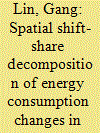| Srl | Item |
| 1 |
ID:
149765


|
|
|
|
|
| Summary/Abstract |
Free interregional mobility of capital refers to the efficiency of resource allocation. Using a general spatial autocorrelation model that extends the traditional Feldstein–Horioka (FH) test, we analyze Chinese provincial data for the periods before and after 1993, and show that the FH coefficients differ to those in the existing literature. During China's period of reform and opening up between 1979 and 1992, the FH coefficient is significantly negative or not statistically significant. However, for the period after 1994, the FH coefficient is significantly higher than that shown in prior studies. This study explains this phenomenon from the perspective of Chinese-style decentralization. The FH test is an indirect method of showing regional capital mobility. Therefore, we need some form of direct measurement. Thus, we use the rate of the proportional change in physical capital stock as a proxy variable to demonstrate capital mobility directly, and use it to analyze various factors affecting Chinese provincial capital mobility. When investigating these factors, and to establish a realistic foundation on which the spatial effects take place, we devise four spatial weight matrices from the perspectives of geographical features and economic characteristics. Lastly, in order to promote regional capital mobility in China, the Chinese central government needs to take urgent measures to change local governments' strong preferences for GDP under the pressure of political promotion.
|
|
|
|
|
|
|
|
|
|
|
|
|
|
|
|
| 2 |
ID:
169884


|
|
|
|
|
| Summary/Abstract |
The objective of this paper is to investigate the changes in the regional energy consumption at the provincial level in China from 2007 to 2016 by introducing a spatial shift-share decomposition approach to measure the neighborhood effect on the regional energy efficiency change through the establishment of a spatial weight matrix considering the geographical and economic proximity. Using this decomposition method, the regional advantage (or disadvantage) in energy efficiency can be revealed, excluding the influence of neighborhood performance in terms of energy efficiency. The results indicate that a shift from energy intensive industrial productions toward the less energy intensive service sector occurs in almost all provinces of China over the period observed; there is significant spatial differentiation on the spatial decomposition of the efficiency change component across provinces, and the changes in energy efficiency in provinces of Jing-Jin-Ji, Yangtze River Delta, Chengdu-Chongqing, Guanzhong Plain, Pan-Pearl River Delta city agglomeration and the three provinces in Northeast China are mainly affected by the neighborhood effect. Our empirical findings suggest that energy policy making should be more concerned about the spatial correlation and coupling effects of energy consumption, especially in the national urban agglomeration of China.
|
|
|
|
|
|
|
|
|
|
|
|
|
|
|
|